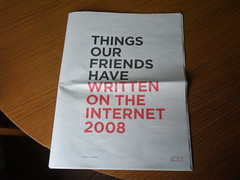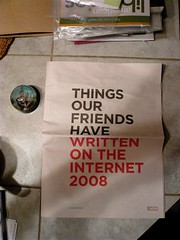Reports of the demise of newspapers, radio, TV, and other traditional media have been greatly exaggerated over and over again through several decades now. But when the so-called “new media” head offline to show up in traditional media clothes, is that a step backward or is it just the natural evolution of communications?
On January 29, I was speaking at a local event in Toronto, and had the opportunity to attend a session by Evan Solomon, the co-anchor of CBC News: Sunday. It was a good talk about how the next technology revolution will play out. He pointed out that when a new technology comes, the incumbent never dies: it simply goes after deeper efficiencies. TV never killed radio broadcasting, just forced the old media to discover spaces where the new entrant would not be as efficient. Talk radio, for example, is perfect when you’re driving. Watching TV? Not so much.

Image by I like via Flickr
Coincidentally, on my way back home I was listening to random podcasts in my overgrown playlist, and serendipity showed its face. Spark episode 64 came up, and the great Nora Young (CBC again, sorry 😀 ) was interviewing Ben Terrett, one of the guys behind this:
Photo by Flickr user a.affleck, Creative Commons, Attribution 2.0 Generic
It’s exactly what it looks like. They took 23 blog posts from the Internet and printed them in newspaper format. You can read more about their effort here. Here’s some excerpts from Ben’s words:
We wanted to see what things written specifically for screen felt like when they were printed out. (…) If you print it out, you can take it on the bus, you can take it into the loo, you can actually read it out. So, we thought some things needed a paper-based audience rather than a screen-based audience…The newspaper is not dying but maybe the business model is. The format is still a great way to read stuff. And it is really accessible…We wanted to see what happens if we just print some stuff from the Internet out. And then would that lead to something else?
The podcast goes ahead and mentions two other similar examples: The Printed Blog (“The Best of the Web on your Newsstand”) and Printcasting, a service that “will make it possible for anyone to create a local printable newspaper, magazine or newsletter that carries local advertising–all for free–by pulling together online content from existing sources, such as blogs, and combining it with local advertising that matches the content.”
You may also have read recently that Wikipedia may soon start offering printed books with its popular articles. The contents of the German edition seem to already be available for the PediaPress service, but as my German is as good as my Korean–i.e., non-existent–I couldn’t for the life of me figure out how to do it. It’s interesting to hear from Angela Beesley Starling, chair of the Wikimedia Foundation Advisory Board, that one of the intended objectives for having a print edition is to remove the perception that a wiki-based encyclopaedia is not reliable. That’s exactly the same point that Ben made to Nora: somehow, good ol’ paper feels much more serious, important, authoritative.
In some cases, like with “The Tech Guy” talk show by online celebrity Leo Laporte, it’s even hard to tell if that is a podcast made into a radio show or the other way around. Finally, YouTube has long been rumoured to be flirting with network TV. YouTube is somehow already available on the living rooms via Apple TV or game consoles. I tested it on my Wii this week. The experience is underwhelming, but I definitely see the potential behind it.
In my last Biznology post, I mentioned that the online social media conversation was expanding and becoming increasingly fragmented. Looking at the bigger picture, it may just make sense that social media also expand to the offline side of the spectrum, so that it can extend its reach. Many people are still much more comfortable with paper, TV or radio than with the cyberspace. And there are places where quite frankly people should not take a computer anyway 🙂
Coming back to Evan Solomon’s message, social media is also in a continuous search for deeper efficiencies. This may sometimes just mean reaching out to conventional media, which can expose the existing content to audiences and places that would not otherwise be touched, and also access to new marketing opportunities.


![Reblog this post [with Zemanta]](http://img.zemanta.com/reblog_e.png?x-id=c1bdc84a-75f0-4259-852b-e46cfb4aa8d5)


